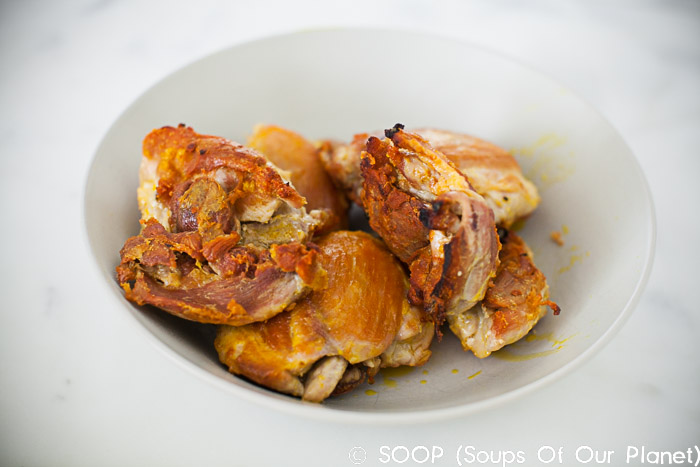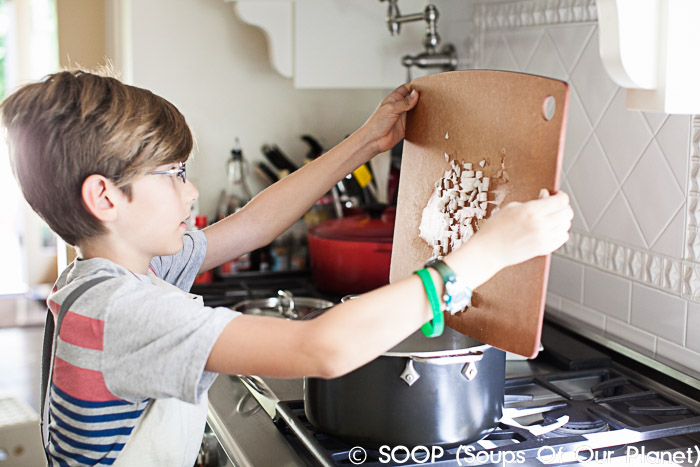REPUBLIC OF CONGO: Muamba Nsusu and Fufu (Chicken and Peanut soup + Yams)
Here’s what we learned about Congo in our research this week:
- Gorillas!
- Pygmies!
- Lonely Planet ranked Republic of Congo #6 in it’s 2015 countries to visit!
- Republic of Congo is also called Congo Republic and Congo Brazzaville.
- Brazzaville is the capital of Republic of Congo and sits directly across the Congo River from Kinshasa, the capital of Democratic Republic of Congo (formerly Zaire).
This video is good for a sampling of what life is like in Brazzaville. You can even hear the singers talking about Fufu at one point!
Muamba Nsusu and Fufu (Chicken and Peanut soup + Yams)
 I’ll admit it. Beckett chose this recipe because he thought Muamba Nsusu was fun to say. Well, first he actually picked fufu and ran around the house for several minutes shouting FUFUFUFUFUFFUFUFUFUFUFUFUUUUUUU before I could settle him down to pick what ELSE we should make seeing as how fufu is actually a starchy side sort of akin to our mashed potatoes. He was set on having something as fun to say as FUFUFUFUFUFFUFUFUFUFUFUFUUUUUUU and therefore picked NSUSUNSUSUNSUSUNSUSUNSUSUNSUSUUUUUUU!
I’ll admit it. Beckett chose this recipe because he thought Muamba Nsusu was fun to say. Well, first he actually picked fufu and ran around the house for several minutes shouting FUFUFUFUFUFFUFUFUFUFUFUFUUUUUUU before I could settle him down to pick what ELSE we should make seeing as how fufu is actually a starchy side sort of akin to our mashed potatoes. He was set on having something as fun to say as FUFUFUFUFUFFUFUFUFUFUFUFUUUUUUU and therefore picked NSUSUNSUSUNSUSUNSUSUNSUSUNSUSUUUUUUU!
As luck would have it, it Nsusu a good pick. I described it to our friends’ boys who weren’t so sure about the stew as “peanut butter soup”. That pretty much nailed it. Very common all over Sub-Saharan Africa, peanuts (called groundnuts in Africa) are used very commonly in various stews combining chicken and tomatoes. This version uses red palm oil, another staple of Sub-Saharan Africa, which some argue is the best type of fat (better than olive oil, coconut oil, and avocados) you can ingest due to its high level of Vitamins A and E.
While the soup Nsusu was a culinary success in our meal, the fufu was, well, let’s call it an acquired taste. Fufu is Sub-Saharan Africa’s answer to our mashed potatoes. It is made many different ways using many different starches, but in Western Africa it is usually made from yams, sometimes combined with plantains. We chose to get half traditional and make it with yams and one plantain, but used the food processor instead of the more traditional way to make fufu (as seen in the video below). I’m not including a recipe for fufu in this post simply because there seem to be a gigazillion different ways to make it, so I’m going to encourage you to get out there and blaze your own fufu path should you feel like running around the house yelling FUFUFUFUFUFFUFUFUFUFUFUFUUUUUUU!!!!
Ahem. Now then. Traditionally, our fun to say stew would be eaten with your hands – more specifically your right hand. Eaters would take a bit of fufu and some stew and quickly slurp it all up by sticking fingers directly into mouths. Had we gone this route, I’m sure the boys would have been thrilled, but we opted for spoons this time.
Would we make it again? Sorry Congo, but the fufu was not a hit. The soup on the other, hand, while much too heavy for me was a hit with the kids… even Dracula.
Muamba Nsusu
Serves 8
Ingredients
- 1.5 pounds skinless/boneless chicken thighs
- 2 tablespoons red palm oil, divided
- 1 large onion, chopped
- 1 large carrot, chopped
- 2 jalapeños, minced
- 1 cup natural peanut butter (peanuts and salt only- no other ingredients)
- 1 can tomato paste (6 ounces)
- 1 teaspoon cumin
- 1 can chopped tomatoes (14.5 ounces)
- zest of one small lemon
- 6 cups chicken stock
- 1/4 cup peanuts
Instructions
- Generously salt and pepper chicken thighs. In large heavy soup pot, add 1 tablespoon red palm oil, then cook chicken thighs over medium heat until chicken is no longer pink and the juices run clear. This should take 8 to 12 minutes. As the chicken cooks, turn it occasionally so it browns evenly. Once chicken has cooked and browned, remove it from pot and set aside to cool.

- Add palm oil to pot and melt over medium-low heat. Sauteé onions, carrots and chilies (scraping up any browned bits from the chicken) until well caramelized.


- Meanwhile, in a small bowl combine peanut butter, tomato paste and cumin with 1 cup of the chicken broth and stir to combine well.

- Add peanut/tomato mixture to the pot along with the tomatoes, lemon zest, cooking for a few moments until fragrant.

- Add chicken stock and bring to a simmer. Shred or chop chicken thighs and return to the soup. Add peanuts. Simmer until soup has thickened.
- Check for seasonings – adding salt, pepper, lemon, sugar, or cumin as needed.
- Serve with fufu
Cook’s Notes
Red Palm oil is available at Whole Foods and online.
Also, yams are kind of hard to peel – says Beckett.







 weekend was a fantastic white from the foot of the Mátra mountains. This description from the importer nails it:
weekend was a fantastic white from the foot of the Mátra mountains. This description from the importer nails it:







 sent our friends to scour San Francisco. When their search left them empty-handed, we learned that jackfruit goes out of season in September. Oh well. To the right is what it would have looked like had we found it fresh (keep in mind that this is the size of a large watermelon covered with spikes.
sent our friends to scour San Francisco. When their search left them empty-handed, we learned that jackfruit goes out of season in September. Oh well. To the right is what it would have looked like had we found it fresh (keep in mind that this is the size of a large watermelon covered with spikes.





















